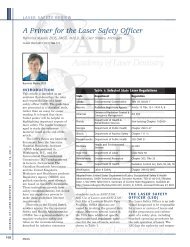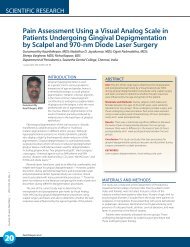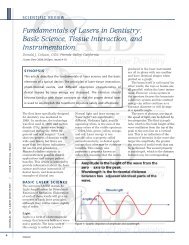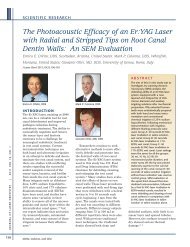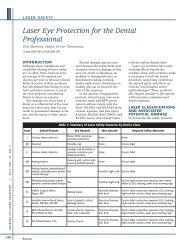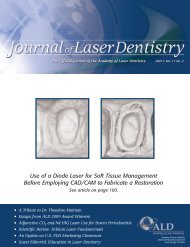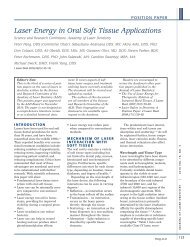Create successful ePaper yourself
Turn your PDF publications into a flip-book with our unique Google optimized e-Paper software.
C L I N I C A L E X P E R I E N C E<br />
Using Photobiomodulation on a Severe<br />
Parkinson’s Patient to Enable Extractions, Root<br />
Canal Treatment, and Partial Denture Fabrication<br />
Mel A. Burchman, DDS, Langhorne, Pennsylvania<br />
J <strong>Laser</strong> Dent 2011;19(3):297-300<br />
Mel A. Burchman, DDS<br />
I N T R O D U C T I O N<br />
The objective <strong>of</strong> this presentation is<br />
to demonstrate how low-level laser<br />
stimulation <strong>of</strong> acupuncture points<br />
may be used to temporarily relieve<br />
the tremors <strong>of</strong> Parkinsonism,<br />
thereby enabling various dental<br />
treatments.<br />
Acupuncture, as defined by the<br />
American <strong>Academy</strong> <strong>of</strong> Medical<br />
Acupuncture (AAMA), may be<br />
defined as “a method <strong>of</strong> encouraging<br />
the body to promote natural<br />
healing and to improve functioning.<br />
This is done by inserting needles<br />
and applying heat or electrical<br />
stimulation at very precise<br />
acupuncture points.” 1 <strong>Laser</strong>s and<br />
ultrasound are other means <strong>of</strong><br />
stimulating the acupoints.<br />
Dorland’s Illustrated Medical<br />
Dictionary states: “According to<br />
traditional theory, the goal <strong>of</strong><br />
acupuncture is the prevention and<br />
treatment <strong>of</strong> disease by correcting<br />
disturbances in the flow <strong>of</strong> qi (“life<br />
energy”); biologically, the effects <strong>of</strong><br />
acupuncture may result from the<br />
release <strong>of</strong> neurotransmitters such<br />
as endorphins and serotonin.” 2<br />
The AAMA further explains how<br />
acupuncture works: “The classical<br />
Chinese explanation is that chan-<br />
nels <strong>of</strong> energy run in regular<br />
patterns through the body and over<br />
its surface. These energy channels,<br />
called meridians, are like rivers<br />
flowing through the body to irrigate<br />
and nourish the tissues. An<br />
obstruction in the movement <strong>of</strong><br />
these energy rivers is like a dam<br />
that backs up in others. The meridians<br />
can be influenced by<br />
stimulating the acupuncture<br />
points.” 1<br />
How light may be used to stimulate<br />
such points is described by<br />
Vargas, who reported that Russian<br />
researchers from the Institute for<br />
Clinical and Experimental<br />
Medicine showed that “only certain<br />
areas <strong>of</strong> the body were able to<br />
transfer light beneath the surface,<br />
and these areas corresponded to<br />
acupuncture points. Furthermore,<br />
the light was conducted within the<br />
body along the acupuncture meridians.<br />
It appears that the meridians<br />
are a light transferal system within<br />
the body somewhat like optical<br />
fiber.” 3<br />
Instead <strong>of</strong> using needles, heat,<br />
electrical current, or ultrasound to<br />
stimulate certain acupuncture<br />
points, the present case describes a<br />
method <strong>of</strong> photobiomodulation<br />
using a combination <strong>of</strong> low-level<br />
laser and light-emitting diode<br />
instruments to enable dental treatment<br />
<strong>of</strong> a patient with severe<br />
Parkinson’s and positively affect<br />
outcome.<br />
So what do we know about<br />
Parkinson’s disease? It is a degenerative<br />
disorder <strong>of</strong> the central<br />
nervous system that impairs motor<br />
skills, speech, and other functions.<br />
Primary symptoms, including<br />
tremor <strong>of</strong> resting muscles, rigidity,<br />
slowness <strong>of</strong> movement, and<br />
impaired balance, are the result <strong>of</strong><br />
decreased stimulation <strong>of</strong> the motor<br />
cortex by the basal ganglia,<br />
normally caused by the insufficient<br />
formation and action <strong>of</strong> dopamine.<br />
Hence, Parkinson’s disease is<br />
related to low levels <strong>of</strong> dopamine in<br />
certain parts <strong>of</strong> the brain. An<br />
increase in dopamine concentrations<br />
in the brain is thought to<br />
improve nerve conduction and to<br />
assist in lessening the movement<br />
disorders in patients with this<br />
condition.<br />
Dopamine is a neurohormone<br />
released by the hypothalamus. Its<br />
main function is to inhibit the<br />
release <strong>of</strong> prolactin from the anterior<br />
lobe <strong>of</strong> the pituitary gland.<br />
Dopamine is a catecholamine and<br />
an important neurotransmitter<br />
(messenger) in the brain. Begley<br />
states that dopamine is “the precise<br />
chemical that is scarce in the brains<br />
<strong>of</strong> Parkinson’s patients. Dopamine<br />
… calms the chaotic neuronal firing<br />
that causes the spasms and rigidity<br />
<strong>of</strong> Parkinson’s … ” 4-5<br />
The hypothalamus contains a<br />
number <strong>of</strong> small nuclei with a<br />
variety <strong>of</strong> functions. The most<br />
important <strong>of</strong> these is to link the<br />
nervous system to the endocrine<br />
system via the pituitary gland. The<br />
hypothalamus is located below the<br />
thalamus, just above the brain<br />
stem. Important to understanding<br />
this case is the fact that the hypothalamus<br />
is stimulated by light.<br />
Choice <strong>of</strong> which light-emitting<br />
instrument to use is guided by<br />
Burchman<br />
J O U R N A L O F L A S E R D E N T I S T R Y | 2 011 V O L . 19 , N O . 3<br />
297





